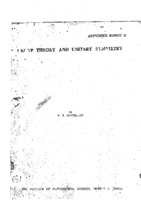- DSpace Home
- →
- MATSCIENCE Reports
- →
- MATSCIENCE Reports
- →
- View Item
JavaScript is disabled for your browser. Some features of this site may not work without it.
| dc.contributor.author | Santhanam, T.S. | |
| dc.date.accessioned | 2010-09-03T06:19:16Z | |
| dc.date.available | 2010-09-03T06:19:16Z | |
| dc.date.issued | 2010-09-03T06:19:16Z | |
| dc.date.submitted | 1968 | |
| dc.identifier.uri | https://dspace.imsc.res.in/xmlui/handle/123456789/228 | |
| dc.description.abstract | The introductory chapter on Elementary particles gives an account of Interaction between particles, like Electromagnetic interaction, Strong interactions, weak interactions and it also reviews the Dirac Equation. This report deals with Group Theory, Lie Algebra, Lie Groups, Classical Groups, Root Structure, Representations of Lie Group and Lie Algebras and Unitary Groups. The report also talks about 'Discrete Transformation', where CPT and their Implications and Reactions are described and definitions of Conjugation is given. In the chapter "Generating functions of classical groups and evaluation of partition functions", the concepts like properties of simple reducibility, Equivalence of an irreducible representation and its conjugates, multiplicity, internal multiplicity structure are discussed. Recursion relations for the internal multiplicity is obtained. The general discussion of 'Kostant's formula', the Weyl group, the structure of positive and primitive roots, and the diophantine equations are dealt with. Conclusion: The Generating function for various classical groups have been constructed which are then used to set up recursion relations for the partition function which enter the Kostant's formula for the inner multiplicity structure. The essential idea of the whole analysis is the realization that the number of solutions of the matrix equation K = Ca ( for given k and c) where the matrix C is in general a rectangular matrix with non-negative integer coefficients, and the components of the vectors k and a are again non-negative integers, given by the coefficients of x1^k1, ... xl^kl of the generating function. The connection between the internal and external multiplicity structures are also discussed. | en_US |
| dc.subject | Group Theory | en_US |
| dc.subject | Unitary Symmetries | en_US |
| dc.subject | Matscience Report 61 | en_US |
| dc.title | Group Theory and Unitary Symmetry[MatSciRep:61] | en_US |
| dc.type.institution | Institute of Mathematical Sciences | en_US |
| dc.description.pages | 23; 38; 23p. | en_US |
| dc.type.mainsub | Mathematics | en_US |
